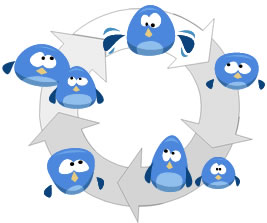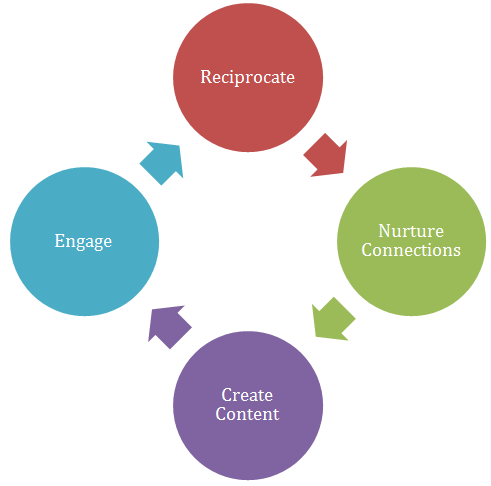A Virtuous Cycle Of Twitter Community Management
What if a prominent journalist followed a brand’s Twitter account and no one noticed? No one on behalf of the brand reciprocated the follow. In an ideal situation, the journalist would have been thanked, added to a list, and engaged. Ouch! It’s easy for community managers to get caught up in the daily and hourly […]
 What if a prominent journalist followed a brand’s Twitter account and no one noticed? No one on behalf of the brand reciprocated the follow.
What if a prominent journalist followed a brand’s Twitter account and no one noticed? No one on behalf of the brand reciprocated the follow.
In an ideal situation, the journalist would have been thanked, added to a list, and engaged. Ouch!
It’s easy for community managers to get caught up in the daily and hourly flow of all the bits of information coming and going, and as a result, miss critical activities. To prevent these types of omissions, develop your own Twitter workflow for the people managing your Twitter community.
It can help to think through the four main groups of activities:
- Reciprocation – follow people back, say “thank your” or simply answer a question
- Nurturing of Connections – find new people to connect with, follow them, and then make a real connection to the person
- Content Creation – create interesting content, through original authorship or curation
- Engagement – get involved in conversations and chats
These activities can flow in a cycle that slowly builds up more and more brand equity, influence, connections, and influence. In economics, this is referred to as a virtuous cycle.
It could look like this:
Reciprocate
 Did anyone include your name in a comment, or directly to you? If so, answer.
Did anyone include your name in a comment, or directly to you? If so, answer.
- Did anyone retweet you? If so, thank them.
- Did anyone new follow you? If so, are they real/interesting/relevant? If so, follow them back.
- Is there anything interesting in your stream to reply to? Particularly with the new people… If your daily new followers are 25 or fewer, it isn’t difficult to look over those new followers and see if there is an opportunity to engage. If your daily new follower count is much higher, this can be difficult, but still very much worth the effort.
Nurture New Connections
 Follow new people. Do you have a plan for following new people (if you’re trying to build your Twitter following, you should be, yourself, following new people every day)? You might follow new people based on:
Follow new people. Do you have a plan for following new people (if you’re trying to build your Twitter following, you should be, yourself, following new people every day)? You might follow new people based on:
- Use of certain key phrases in tweets or profiles
- People within a certain geographic area if your organization is local in nature
- People that are in mutual networks (following, being followed, or mutually following one another)
Creating Content
 We’ve entered into a time in which “content marketing” has become a cherished buzzword and concept. Even clichés can represent an eternal vérité; however, so even if you haven’t used the phrase “Content is King” in the past six months, content is by and large the stuff that makes up the Internet. It’s the cosmic dust and ether of our online universe.
We’ve entered into a time in which “content marketing” has become a cherished buzzword and concept. Even clichés can represent an eternal vérité; however, so even if you haven’t used the phrase “Content is King” in the past six months, content is by and large the stuff that makes up the Internet. It’s the cosmic dust and ether of our online universe.
Here are some of the things you can try to capitalize on content:
- Curating content found elsewhere that is relevant
- Sharing events like trade shows and conferences
- Creating a “story,” that is, a series of tweets that have a cohesive narrative
Engage
 Of course, in engaging, you’re creating content, too. But it’s content that has an extra jolt of unicorn sparkles, because it’s interaction with other people. That is, after all, where all the magic of this stuff we call social media occurs.
Of course, in engaging, you’re creating content, too. But it’s content that has an extra jolt of unicorn sparkles, because it’s interaction with other people. That is, after all, where all the magic of this stuff we call social media occurs.
Some magical ways to engage include:
- Responding to what someone else has tweeted – many of the most effective users of Twitter are directly tweeting to others (a tweet beginning with @SomeonesName)
- Retweeting great and relevant content
- Joining in or even being a guest on Twitter chats
- Bringing relationships offline by meeting people
Using Lists
Using lists can help in all four areas of activity. By creating interesting lists and adding individuals to those lists, you’re giving a “micro-gift” to that person – showing that you find them interesting. The list is in itself a piece of content that you can share with others. How you name lists and group people can in itself tell a story.
And finally, by keeping Twitter lists, you can more easily engage with people. Remember, people aren’t notified when a list is deleted – only when they are added to a list. Include list maintenance in your Twitter community management cycle to keep this important feature active.
Once you’re following over a few thousand people on Twitter, using those lists will be the easiest way to keep track of people based on subject expertise, geographical area, level of influence, or other criteria.
Tools Of The Trade
![]() Tools can often help you do many of the tasks mentioned above more easily than the Web-based version of Twitter. Even working in one of the common 3rd party Twitter interfaces like Hootsuite or Tweetdeck can help you keep an eye on list members in a way that is just plain onerous in the web version of Twitter.
Tools can often help you do many of the tasks mentioned above more easily than the Web-based version of Twitter. Even working in one of the common 3rd party Twitter interfaces like Hootsuite or Tweetdeck can help you keep an eye on list members in a way that is just plain onerous in the web version of Twitter.
Some of the other tools I’ve found useful include:
These suggestions for a Twitter Community Management Guide are by no means meant to be exhaustive. But if you don’t already have your own guide and process, it is a good starting place. If you do find things to add or edit, I’d love to hear from you.
Feature image and accompanying images from VectorStock used under license.
Contributing authors are invited to create content for MarTech and are chosen for their expertise and contribution to the search community. Our contributors work under the oversight of the editorial staff and contributions are checked for quality and relevance to our readers. MarTech is owned by Semrush. Contributor was not asked to make any direct or indirect mentions of Semrush. The opinions they express are their own.
Related stories
